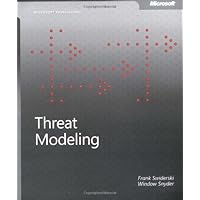
Average Reviews:

(More customer reviews)In my review Thread Modeling (spelt with captials) refers to the book, thread modeling (spelt without capitals) refers to the subject.
Open the cover of this book and the first thing you see in large, bold print is `Reviewer Acclaim for Frank Swiderski, Window Snyder, and Threat Modeling'. I doubt that I'm the only one to notice that ALL the quotes are from current Microsoft employees! Look further and you notice that the content stops and the appendixes start on page 173 (of a 259 page book).
Considering that Chapter 4 of Writing Secure Code 2nd Edition does a much better job or covering threat modeling, you have to wonder what sort of padding is going on to fill 172 pages. In fact, I have to say the signal to noise ratio of this book isn't very good at all - unless you are interested in applying threat modeling to the security of your home or touch-tone telephone system!
If you know anything about threat modeling already, you'll also want to know why all (and I mean ALL - no exceptions) of the threat diagrams in this book show a DREAD score of 0 - why wasn't somebody proof reading this stuff? I don't expect to have to wait long before hearing "MS don't take security seriously - in their latest book they've rated [insert favorite threat here] a 0!"
The diagrams in Threat Modeling are also unnecessarily harder to read than the diagrams in Writing Secure Code. Threat Modeling uses the same square boxes for unmitigated conditions and mitigated conditions. This makes it impossible to tell at a glance whether a threat is outstanding or not. Writing Secure Code's use of circles for Mitigated / Resolved conditions at the leaf of the tree made it easy. I also miss Writing Secure Code's use of dotted lines to indicate unlikely attack paths.
Threat Modeling is not without some redeeming features. The idea and reasons for reducing the DREAD range from 1-10 to 1-3 is a welcome refinement and non-programmers may find the wealth of non-relevant examples helpful in assimilating the underlying concepts. Threat Modeling also covers DFDs (Data Flow Diagrams) which Writing Secure Code regrettably does not.
Threat Modeling is not a complete waste of space. It covers the material it sets out to cover and you should have no trouble producing threat models are reading this book. But if you only have time to read (or the money to buy) one MS security book, you won't regret making it Writing Secure Code instead.
Click Here to see more reviews about: Threat Modeling (Microsoft Professional)
In this straightforward and practical guide, Microsoft® application security specialists Frank Swiderski and Window Snyder describe the concepts and goals for threat modeling—a structured approach for identifying, evaluating, and mitigating risks to system security. Discover how to use the threat modeling methodology to analyze your system from the adversary's point of view—creating a set of data points that help drive security specifications and testing. You'll review application scenarios that illustrate threat modeling concepts in action, understanding how to use threat modeling to help improve the built-in security of a system—as well as your customer's confidence in the security of that system—regardless of development environment.
Gain an in-depth, conceptual understanding—along with practical ways to integrate threat modeling into your development efforts:
Help anticipate attacks by seeing how adversaries assess your system—and compare their view to the developer's or architect's view
Employ a data flow approach to create a threat profile for a system
Reveal vulnerabilities in system architecture and implementation using investigative techniques such as threat trees and threat model-directed code reviews
Develop a credible security characterization for modeling threats
Use threat modeling to help verify security features and increase the resilience of software systems
Increase customer confidence in your products!
Click here for more information about Threat Modeling (Microsoft Professional)

No comments:
Post a Comment